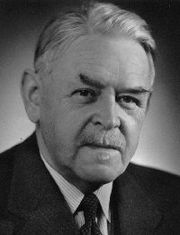Vilhelm Buhl
Vilhelm Buhl | |
|---|---|
 | |
| Prime Minister of Denmark | |
| In office 4 May 1942 – 9 November 1942 | |
| Monarch | Christian X |
| Preceded by | Thorvald Stauning |
| Succeeded by | Erik Scavenius |
| In office 5 May 1945 – 7 November 1945 | |
| Monarch | Christian X |
| Preceded by | German military rule (last Prime Minister: Erik Scavenius) |
| Succeeded by | Knud Kristensen |
| Personal details | |
| Born | 16 October 1881 Fredericia |
| Died | 18 December 1954 (aged 73) Copenhagen |
| Political party | Social Democrats |
Vilhelm Buhl (16 October 1881 – 18 December 1954) was Prime Minister of Denmark from 4 May 1942 to 9 November 1942 as head of the Unity Government (the Cabinet of Vilhelm Buhl I) during the German occupation of Denmark of World War II, until the Nazis ordered him removed. He was Prime Minister again from 5 May 1945 to 7 November 1945 as head of a unity government (the Cabinet of Vilhelm Buhl II) after the liberation of Denmark by the British Field Marshal Montgomery.
Vilhelm Buhl was a member of the Social Democrats, and had held the post of Finance Minister in the cabinets of Thorvald Stauning from 20 July 1937 to 4 May 1942.
During Nazi Germany's occupation of Denmark, Thorvald Stauning had created a unity government. When Thorvald Stauning died in May 1942, Vilhelm Buhl succeeded him. This government only lasted six months, because of a diplomatic incident, the Telegram Crisis, in which King Christian X sent a short and formal reply to a long birthday telegram from Adolf Hitler. Hitler was outraged by this insult, and as a result Vilhelm Buhl was replaced by Erik Scavenius. Werner Best was sent to Denmark as a new tough Nazi commander.
After the liberation of Denmark on 5 May 1945, the politicians and the resistance fighters formed a unity government (Cabinet of Vilhelm Buhl II). Many Danes were dissatisfied with the politicians because of their policy of cooperation with the Germans that had dominated at the start of the war, hence the inclusion of the resistance fighters. Notable members of the cabinet included Aksel Larsen, Hans Hedtoft, H. C. Hansen, Knud Kristensen and John Christmas Møller. In social policy, the government presided over the passage of the Housing Obligation Act of August 1945, introduced obligatory allocation of vacant housing to ensure that vacant flats were let in the first instance to those with low incomes, while also establishing tight rent controls. The government also presided over the trials of the people who had cooperated with the Germans, as a result of which 45 persons were executed. After the elections in October 1945 Knud Kristensen became the new prime minister.
References
- Kristian Hvidt, Statsministre i Danmark fra 1913 til 1995 (1995)
- Growth to Limits: The Western European Welfare States Since World War II, Volume 4 edited by Peter Flora
- 1881 births
- 1954 deaths
- Prime Ministers of Denmark
- Danish Finance Ministers
- Foreign ministers of Denmark
- Danish Justice Ministers
- World War II political leaders
- Danish people of World War II
- Members of the Folketing
- Members of the Landsting (Denmark)
- People from Fredericia
- Burials at Vestre Cemetery, Copenhagen
- 20th-century Danish politicians

